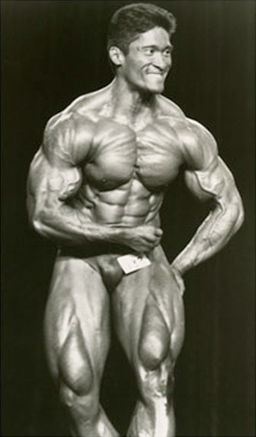About Ming Chew
The Evolution of a Bodybuilder
Born and raised in Brooklyn, New York, I was the only Chinese-American boy in my neighborhood, constantly getting picked on by the other kids. Then in 1977, when I was 14, I saw a picture of Arnold Schwarzenegger in the book Pumping Iron, and it changed my life. I said to myself, “Wow, if I looked like that, I’d never get picked on again!”
Bruce Lee was also popular back then. He was Chinese American too, and he fought people with his fists. So I thought, what better way to protect myself than to build up my muscles, so people would fear me, and I wouldn't have to fight them? I started to train. By the time I was 16, I had gained 40 pounds of muscle, and all the tormenting stopped. In fact I suddenly had new friends - the same guys who used to attack me - full of questions about training. And I never had to fight anyone.
I became a bodybuilder, and won many titles, including Mr. Teenage New York, Mr. New York, and Mr. Empire State. I was ranked nationally and featured on magazine covers.
In 1984 I graduated from Columbia University with a chemistry degree. Initially I planned to go to medical school, but realized that my passion was to work with my hands on people’s bodies. Bodybuilding had given me a good understanding of how the human body worked, and I wanted to make it stronger and better. So I went to physical therapy school and in 1987 began working as a conventional physical therapist. But all the time I knew in my core that something was missing.
From bodybuilder to healer
In 1991, I retired from bodybuilding. In 1996 I started training under Renzo Gracie, a Brazilian jujitsu black belt and no-holds-barred fighter, earning a blue belt. Then, during a competition, I injured my left shoulder so badly I thought it was irreparably damaged. I had standard physical therapy for it, but the results were terrible. My arm remained very weak, and I was in severe pain. I tried ultrasound, electric stimulation, ice packs, and ibuprofen — exactly what doctors recommended and what I myself advised my patients to do — but nothing worked.
Then I met a chiropractor who said, “I can help your shoulder in a few sessions.” Naturally, I laughed. I believed my doctor, who had said I needed surgery. But I let the chiropractor give me two 20-minute treatments. In two days, the shoulder was significantly better.
What the chiropractor did was treat my fascia, using Active Release Techniques, a type of therapy that targets this tissue. And I realized that fascial therapy was the missing link I’d been seeking—not only for myself, but for my practice.
For the next eight years, I studied fascial therapy. I saw dramatic changes in my practice: it now took only one to four weeks, and sometimes less than a single session, to heal my patients. Over the years I’ve modified what I do so it barely resembles what I was originally taught, but my work still follows the basic principle of releasing fascia. Meanwhile, I got my shoulder to 70% of function—but I wanted it to be still better.
Then I met Dr. Guy Voyer, the originator of a series of special stretches that release the fascia. Learning fascial stretching transformed me and my work. I used the stretches for my shoulder, and got it to 95 percent.
I also added stretching to my practice, creating my own stretches and modifying many of the originals. They’ve really boosted my cure rate. All my patients now get a stretch program as homework.
In the vast majority of cases, Ming Manual Therapy is much faster and less risky than standard medical treatment, and it saves thousands of dollars. I truly believe that MMT and the Ming Method can make 40–50% of orthopedic surgeries unnecessary. So don’t take those powerful painkillers, or agree to surgery, before you’ve given it a shot.
Ready to take that next step on the journey to being pain-free? What was once only available to elite, high-profile athletes and celebrities is now available to you. Find out for yourself. Get rid of your pain now by making an appointment with Ming.



